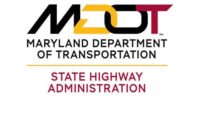Maryland Gov. Wes Moore (D) has announced that the state will pursue public financing to address longstanding congestion issues on portions of its suburban Washington, D.C., Interstate highways—abandoning a stalled $7.3-billion public-private-partnership approach advocated by his predecessor.
Totaling about $4 billion, Moore’s plan calls for rebuilding the 1970s-era American Legion Bridge, a frequent choke point on the west side of the I-495/Capital Beltway connecting Maryland and Virginia. Managed travel lanes would be added in phases along the Beltway from the bridge to the I-270 West Spur, and along the I-270 corridor. The proposal would also increase bus transit options and pedestrian/bicycle access, with a shared-use path on the new bridge linking trail networks on both sides.
The state has already submitted an application for a $2.4-billion federal Multimodal Project Discretionary Grant funded by the 2021 Infrastructure Investment and Jobs Act, according to a Maryland Dept. of Transportation statement. The state will also contribute $800 million in matching funds to the proposal, and pursue other federal grant options with Virginia and local jurisdictions.
Moore’s proposal officially ends the ambitious, yet controversial public-private partnership (P3) advanced by then-Gov. Larry Hogan (R), which was criticized by local and state leaders, environmental groups and local residents for its cost, potential disruptive impacts and lack of transit alternatives.
The P3 program was idled after the March 2023 withdrawal of the Transurban-led development consortium, which cited ongoing legal challenges and political changes brought by the 2022 election of Moore, a vocal opponent of the plan.
Critics also pointed to difficulties surrounding Maryland’s other major P3 infrastructure project—the Purple Line light rail system, which is five years behind schedule and nearly double the original $1.8-billon construction cost.
Moore’s proposal allows for what the state DOT statement calls a “rational and fiscally prudent phased development” of the capacity improvements. The initial effort would include new bridge and Beltway managed lanes first, leaving the planned I-270 corridor sections for a later phase. The agency will also launch a formal environmental study to identify transportation needs along additional sections of I-270, and “evaluate multimodal approaches for near-term implementation and construction.”
The agency will purchase the preliminary engineering and preconstruction work performed by the P3 group for $500,000, according to Jim Joyner, the DOT's spokesperson. The existing Record of Decision from the I-495 & I-270 Managed Lanes Study, issued in August 2022, also will be used for the initial managed lanes implementation, says Joyner.
This decision has been approved, but some federal permits, such as from the U.S. Army Corps of Engineers, are still pending, Joyner adds. “Any new projects within this program will require their own environmental approvals and permits,” he says.
While the agency is focused on exploring the expanded range of federal grants from the 2021 infrastrcture law, it "is not ruling out other options that could include private funding,” adds Joyner.
As for a potential timeline for design and construction, Joyner notes “it is certainly several years away,” with the grant application process just starting and an extensive public engagement effort needed.




